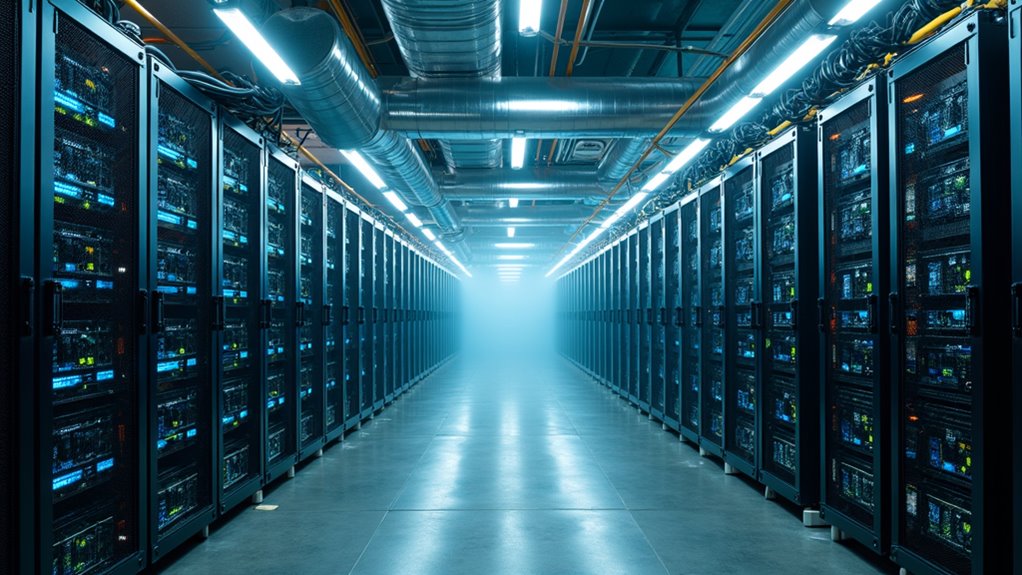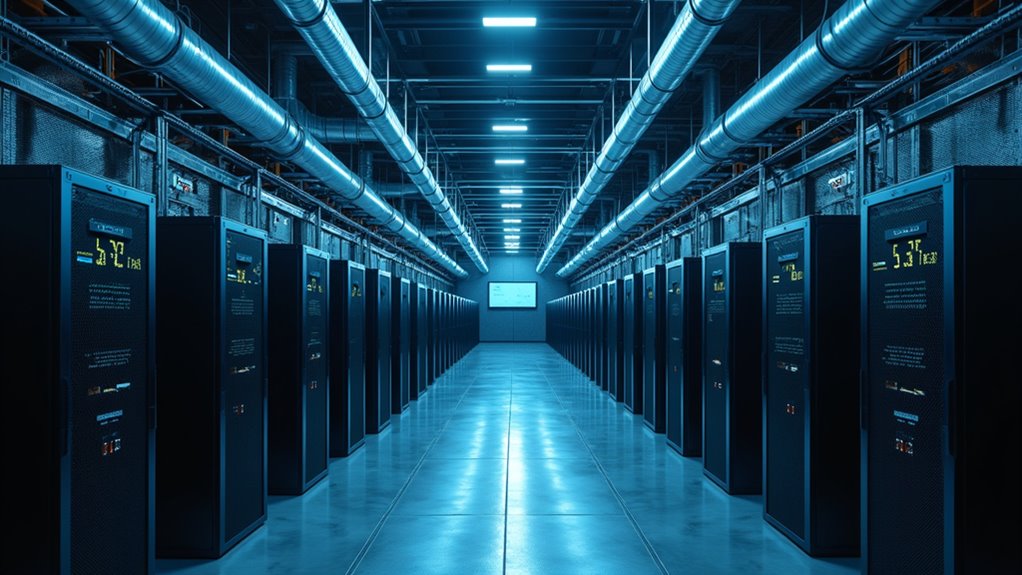A cryptocurrency farm is an industrial-scale mining operation housing thousands of specialized computers that solve complex math problems to earn digital currency rewards. These massive facilities strategically position themselves close electricity sources and require serious cooling systems to prevent their hardware from melting down. Mining farms consume more power than some small countries – yeah, seriously. The economics are brutal: tight margins, constant upgrades, and average Bitcoin mining costs $37,856. There’s way more to this digital gold rush than meets the eye.

While most people imagine cryptocurrency mining as a lone computer humming in someone’s basement, the reality is far more industrial. Cryptocurrency farms are massive operations housing thousands of specialized computers, all working together to validate blockchain transactions and mint new digital coins. These aren’t your average PCs – we’re talking about highly specialized machines called ASICs or souped-up GPUs that do nothing but crunch numbers all day long. Halving events occur every four years, significantly impacting farm operations by reducing mining rewards.
Modern crypto mining isn’t a hobby – it’s an industrial-scale operation with warehouse-sized facilities running specialized equipment around the clock.
These farms are strategic operations, carefully placed in locations where electricity is dirt cheap. Because let’s face it – running thousands of power-hungry computers isn’t exactly kind to the electric bill. The smartest operators join mining pools, combining their computing power with others to increase their chances of scoring those precious crypto rewards. They rely heavily on reliable internet connections to maintain continuous mining operations.
And boy, do these machines run hot. Without serious cooling systems, they’d melt faster than ice cream in July.
The economics of crypto farming is a wild ride. Revenue comes from transaction fees and block rewards, but profitability swings wildly with market prices. One day you’re printing money, the next you’re barely covering your electric bill. Smart farm operators know they need to remain flexible and adapt quickly to market changes. They also need to keep an eye on regulations – governments aren’t exactly thrilled about operations consuming as much power as small cities. With production costs averaging mining cost per Bitcoin of $37,856, operators must maintain tight profit margins to stay viable.
Speaking of power consumption – here’s where things get sticky. These farms are energy hogs, plain and simple. Some critics compare their carbon footprint to that of small countries. But the industry is slowly transforming, with some farms switching to renewable energy and newer, more efficient technologies. They’re also getting creative with cooling solutions, because when you’ve got thousands of machines running 24/7, heat management becomes a serious challenge.
Technology keeps progressing, making these operations more efficient. Better hardware, faster networks, smarter software – it’s a constant race to stay competitive. Because in the crypto farming domain, efficiency isn’t just about being green – it’s about survival.
Frequently Asked Questions
How Much Electricity Does a Typical Cryptocurrency Mining Farm Consume Monthly?
A typical cryptocurrency mining farm’s monthly electricity consumption varies considerably but can range from several hundred megawatt-hours to thousands, depending on size, with large facilities potentially consuming millions of kilowatt-hours monthly.
What Happens to Mining Farms When Cryptocurrency Prices Crash Significantly?
When cryptocurrency prices crash greatly, mining farms face reduced revenues, potential operational losses, and may shut down temporarily or permanently. Some relocate to areas with cheaper electricity or switch to mining alternative cryptocurrencies.
Are Cryptocurrency Mining Farms Legal in All Countries?
Cryptocurrency mining farms are not legal in all countries. Several nations, including China, Kosovo, and Ecuador, have banned mining operations, while others maintain strict regulations or impose restrictions due to energy concerns.
How Long Does Mining Equipment Typically Last Before Needing Replacement?
Mining equipment typically lasts 2-5 years, though lifespans vary based on manufacturing quality, maintenance practices, and operating conditions. Well-maintained devices can last longer, while poor conditions may reduce longevity considerably.
Can Residential Neighborhoods Host Small-Scale Cryptocurrency Mining Operations?
Residential neighborhoods can technically host small-scale mining operations, but face considerable challenges including legal restrictions, noise ordinances, power limitations, and environmental concerns. Many jurisdictions actively discourage or prohibit residential mining activities.









